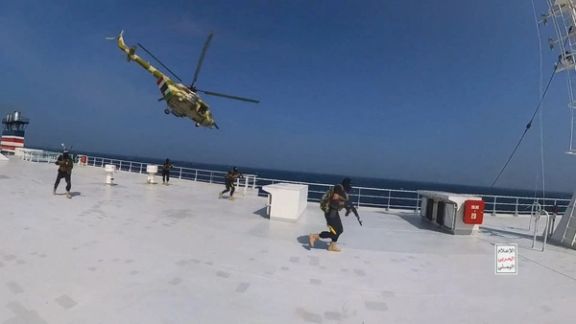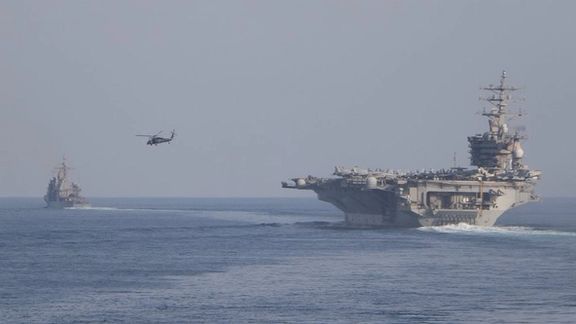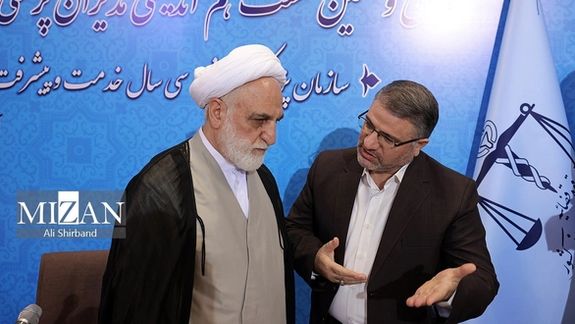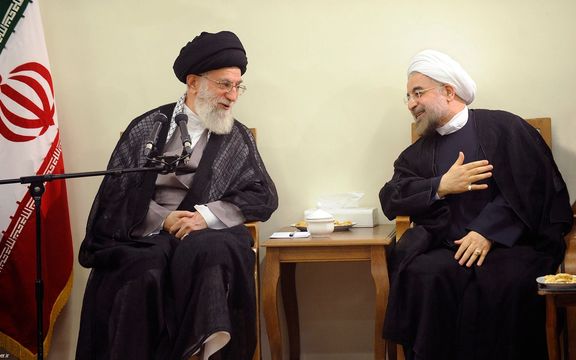Hamas Seeking To Extend Truce As Ceasefire Nears End

As the temporary ceasefire between Israel and Hamas enters its final day, the militant group is actively seeking an extension.

As the temporary ceasefire between Israel and Hamas enters its final day, the militant group is actively seeking an extension.
The ceasefire, initiated on Friday, has resulted in the release of dozens of hostages, with over 100 Palestinian prisoners held on terror charges freed by Israel as part of the agreement.
Hamas is pushing for an extended truce, to give the group time to regroup amidst the devastation inflicted by Israel's relentless retaliation for its massacre of October 7. The designated terror group killed 1,200 mostly civilians and took 240 or more hostage in Gaza.
However, in spite of the fact that over 14,000 Gazans have been killed, including top Hamas commanders, and half of the strip now turned to rubble, Ali Fadavi, the deputy commander of the Islamic Revolutionary Guard Corps (IRGC), asserted on Monday that the Israeli military's perceived invincibility has diminished.
"The invincible image that Israelis had portrayed for military dominance collapsed," he said. "Several hundred individuals breached its seemingly impregnable walls, penetrating tens of kilometers into occupied Palestine."
Israeli Prime Minister Benjamin Netanyahu, addressing his forces in Gaza, conveyed a resolute stance on Sunday, stating that once hostages are released, "Nothing will stop us." He said while the hostage release continues, he would agree to one additional day for every 10 captives released but vowed to continue the war until Hamas is eradicated from the strip.
While Iran takes credit for supporting Hamas financially and militarily over the past two decades, it has refrained from direct military involvement in the current conflict. Instead, its proxies have taken the front line. Even amidst the ceasefire, Lebanese Hezbollah has continued its aggression on Israel's northern border and Yemen's Houthis have taken further actions on vessels in the Red Sea.

Amid the backdrop of the Gaza war, Iranian proxy the Houthis, has stepped up activities in the Red Sea, including strikes on a US vessel.
It has drawn the US into yet another potential conflict in the region as a US Navy warship responded to a distress call from a commercial tanker in the Gulf of Aden that had been seized by the militia.
The Houthis subsequently fired missiles at the USS Mason, which had come to the aid of the hijacked cargo tanker, identified as the Central Park.
US Central Command first released a statement on Sunday claiming that “coalition elements demanded release of the vessel” after coming to its aid. “Subsequently, five armed individuals debarked the ship and attempted to flee via their small boat. The Mason pursued the attackers resulting in their eventual surrender. The crew of the M/V Central Park is currently safe,” it said.
However, in the early hours of Monday morning local time, it said “two ballistic missiles were fired from Houthi controlled areas in Yemen toward the general location of the USS Mason Ason (DDG 87) and M/V Central Park. The missiles landed in the Gulf of Aden approximately ten nautical miles from the ships”.
It came as the troops were concluding the response to the M/V Central Park distress call. “There was no damage or reported injuries from either vessel during this incident”, it confirmed, though raising alarms as to what will be next from the Yemeni militia group.
The Southern Transitional Council in Yemen, which has been fighting the group designated a terror group by countries including the United Arab Emirates and Saudi Arabia, released a statement calling out Iran.
“The Houthi seizure of a vessel in the territorial waters of the Gulf of Aden … is also further evidence that the Houthis are acting as a tool of the Islamic Republic of Iran, obedient to its directives and causing harm to its neighbouring countries.”
Since the Hamas invasion of Israel on October 7, in which 1,200 mostly civilians were killed and another 240 or more hostages taken to Gaza, proxy activity has heightened. On Israel’s northern border, Hezbollah has been increasing its attacks, while proxies in Syria and Iraq have also fired towards its border.

However, it is the Yemeni proxy, the Houthis, which has been the surprise factor, launching both long-range missiles towards Israel and stepping up activities in the Red Sea.
The US was clear in its support of Israel’s right to defend itself in the wake of the single most deadly day for Jews since the Holocaust but as the death toll mounts and Gaza’s destruction continues as Israel vows to wipe out Hamas, both the US and Israel have become the new target of Houthi terror.
A container ship managed by an Israeli-controlled company was hit by a suspected Iranian drone in the Indian Ocean, causing minor damage to the vessel but no injuries, a US defence official said on Saturday.
Earlier this month, the Galaxy Leader was taken to a Yemeni port after the proxy group believed it was owned by an Israeli businessman, though the vessel was operated by Tokyo-based firm Nippon Yusen.
At the time, Israeli PM Benjamin Netanyahu was quick to point the finger at Iran. “This is another Iranian act of terrorism that represents an escalation in Iran’s belligerence against the citizens of the free world, with concomitant international ramifications vis-a-vis the security of global shipping routes,” his office said.
The Southern Transitional Council condemned the “acts of terrorist piracy and calls on the international community to shoulder the grave responsibility of confronting and deterring these threats with the utmost resolve. Houthi actions and persistent terrorist behavior continue to obstruct all peace efforts in the South and Yemen, as well as at the regional level”.
It has reignited the fierce debate over the US redesigning the Houthis, the Biden administration removing the label amidst the humanitarian crisis resulting from years of civil war in Yemen.
It is being weighed at the top levels. “In light of the recent targeting of civilians by the Houthis, and now the piracy of a ship in international waters, we have begun a review of potential terrorist designations, and we’ll be considering other options together with our allies and partners,” National Security Council spokesman John Kirby said.
Experts agree. “A redesignation of the Iran-supported Houthi organization Ansar Allah [Houthis] is long overdue,” said Matt Zweig, Senior Director of Policy for FDD Action, a US-based think tank.
“For far too long, they have threatened and attacked international shipping and US allies and partners in the region. To more effectively combat their sources of funding — including the regime in Iran — the United States should designate Ansar Allah as a specially designated global terrorist organization and a foreign terrorist organization.”
After last year’s attacks in Abu Dhabi, the United Arab Emirates has also been pushing the US to relist the Houthis. UAE and US air defenses prevented mass casualties during three attacks, though the strikes still killed three individuals and injured six.
“The UAE is urging the US to re-list the Houthis as a foreign terrorist organization under US law to disrupt their financial networks and foreign support while providing appropriate exceptions to ensure that humanitarian relief can continue unimpeded”, it wrote in an extensive report which noted the threats the group poses to the US as well as the region.

Religious prisoner Ayub Karimi was moved to solitary confinement last week in preparation for imminent execution in Ghezel-Hesar Prison in Karaj.
The prisoner, a SUnni Kurd, is the latest case rights groups fear will be victim to Iranian crackdowns on dissenting voices among the country's minorities.
According to Hengaw Organization for Human Rights, one week ago, the Kurdish religious prisoner, the father of two children, was taken to the solitary confinement wing.
It follows the execution on November 5 of fellow religious prisoner Ghasem Abesteh, one of Karimi's co-defendants.
Hengaw said that along with Karimi, five more religious prisoners have been identified as also facing imminent execution, Davoud Abdollahi, Farhad Salimi, Anwar Khezri, Khosrow Besharat, and Kamran Sheykha.
All of them were taken into custody in 2009 and were transferred to the detention center of the intelligence agency in Urmia (Orumiyeh) City.
They were tried in 2015, and subsequently sentenced to death. These sentences were confirmed by the Supreme Court in 2020, after years of legal battles. Despite a request for retrial in September 2020, the Supreme Court rejected their plea.
The charges against them include "War against God," "corruption on earth," "support for Salafi groups," and the alleged "murder" of Abdolrahim Tina, who was killed by unidentified assailants in September 2008. However, in letters published by human rights organizations in recent years, the accused individuals consistently denied any involvement in these accusations.
In July alone, Kurdistan Human Rights Network reported that in the past month, Iranian security forces detained at least 54 Kurdish activists and citizens in the western provinces of Iran. Two detainees were sent to prison while the fate of the rest, including two children, remains unknown.

The United States on Sunday deployed its Dwight D. Eisenhower aircraft carrier task force to the Persian Gulf amid continuing tensions in the Middle East.
The US military announced that the Carrier Strike Group Eisenhower (IKECSG) completed a transit of the Strait of Hormuz to enter the waters of the Persian Gulf to support US Central Command missions.
Following the October 7 terror attack on Israel by Hamas and the start of the Gaza war, the US first deployed two strike groups to eastern Mediterranean in what appeared as a deterrence against the Lebanese Hezbollah. The Shiite militant group is believed to possess tens of thousands of missiles and rockets that could bring destruction to Israel. The Hezbollah has since engaged in limited border skirmishes but has avoided a full-scale war with Israel.
Iran’s regime has also chosen not to directly get involved in the Gaza war, although officials issue daily statements of support for Hamas.
The US said that the IKECSG are patrolling the Persian to ensure freedom of navigation in key international waterways while supporting CENTCOM requirements throughout the region.
Iranian officials periodically threaten to close off the Strait of Hormuz or inspect vessels. They have attacked and harassed dozens of commercial vessels in the region since 2019.
“The aircraft carrier USS Dwight D. Eisenhower was accompanied by the guided-missile cruiser USS Philippine Sea, guided-missile destroyers USS Gravely and the USS Stethem and the French frigate Languedo,” the USCENTCOM said.

A political prisoner has called on Iran's chief justice to investigate his revelation that dissident rapper Saman Seydi (Yasin) was subjected to mock execution.
In an open letter addressed to Chief Justice Gholamreza Mohseni-Ejei Thursday, Ahmadreza Haeri has offered more details about the mock execution of a former fellow inmate Yasin, at Ward 240 of Tehran’s Evin Prison.
Yasin whose death sentence was overturned by the Supreme Court in December, in audio files smuggled from prison, has described severe torture including a mock execution during which he was forced to stand on a chair with a noose around his neck after being told to write his last will and testament.
“He is young. One must show mercy. Try to place the noose sideways so that his neck breaks right away when he drops so he doesn’t suffer too much,” Yasin says one of his supposed executioners said to the other.
Then, he says, there was a call after which he was told the execution had been delayed giving him “another chance to cooperate”. Two days later, a real death sentence was handed to him. His wife miscarried her eight-month baby after finding out about the death sentence.
Yasin (27) belongs to the persecuted Kurdish Yarsan religious community and was a vocal critic of the regime before his arrest for supporting the anti-government protests known as the Woman, Life, Freedom movement. He has only attended the court once during his fourteen months of imprisonment and does not have access to his lawyer.

“Form a fact-finding committee consisting of independent lawyers and judges to investigate this matter and allow independent journalists and reports to monitor the committee’s performance,” Haeri wrote.
Haeri alleges that Yasin was taken from his cell in the middle of night and subjected to a mock execution to force him to accept fabricated charges including the use of a combat weapon during last year’s anti-government protests, which would justify a death sentence sought by the prosecutor against him.
According to Haeri, tens of other prisoners heard Yasin’s account of the torture and mock execution he had undergone when he was taken back to the general ward, mentally and physically shattered.
Haeri, a lawyer and human rights activist, is serving a sentence at Ghezel Hesar Prison for exposing the beating of other prisoners at Tehran’s infamous Fashafouyeh Prison in 2014, which led to the death of two inmates, during an incident which came to be known as “Black Thursday”.
State-affiliated media such as the Revolutionary Guards (IRGC) linked Tasnim news agency claimed Wednesday that a new case has been opened against Haeri for not being able to provide proof for the claim in his letter earlier this week that Yasin was subjected to mock execution.
Many other political prisoners and prisoners of conscience have claimed that they were subjected to mock executions to extract confessions that would justify harsh sentences including Sahand Noor-Mohammad-Zadeh, 26, an anti-government protester.
He was accused of setting a trash bin on fire and blocking traffic, both of which he denied. But he had several times been blindfolded and told to climb a chair to be hanged before his trial. He was sentenced to death for moharebeh (enmity against God) and was executed on November 2 last year.
Another protester, Majid Kazemi, said he had undergone mock executions at least fifteen times, in addition to other tortures including upside down suspension and showing him a video of his brother being tortured to “confess” to whatever was dictated to him. Kazemi was also executed on May 19 for “enmity against God”.
In a statement on November 23, the US State Department condemned mock executions and torture of prisoners in Iran with the hashtag #SamanYasin and called on the Iranian authorities to immediately stop “these inhumane practices and conduct fair and transparent trials for their citizens.”

Iran’s former President Hassan Rouhani has for the first time discussed possible arrangements to handle the situation after Supreme Leader Ali Khamenei's death.
He told a group of Iranian moderates including his aides in the previous government on November 20, "This round of the Assembly of Experts election, which is to be held on March 1…, is more important than the previous elections." The Assembly has the constitutional task to select the next Supreme Leader.
Using the mildest language to evade Khamenei’s and his hardliner supporters' anger, Rouhani said, "May the Supreme Leader live long, but as the time passes, the day we would never want to come is more likely to arrive and the Assembly of Experts has to decide on the naming of the next Supreme Leader."
Rouhani added that he had his doubts about whether to register his candidacy for the Assembly of Experts election and that he finally decided to run hoping that he can make an impact on the Assembly's choice in the event of Khamenei's death.
Over the past weeks, when Rouhani revealed that he was a candidate and particularly after the official announcement about the endorsement of his credentials, many conservative media and politicians expressed their opposition to his candidacy although he already is an incumbent member of the assembly. Earlier, a state TV presenter asked the Guardian Council on live television to disqualify him.
Rouhani said at the meeting with his aides that the state TV is at its lowest point in terms of popularity and people's trust.

He said he is well familiar with the hardliners who are currently in control of the government and parliament, adding they would do anything to make sure that he cannot run. However, he insisted that he would encourage everyone to take part in the elections.
Many in the reformist and moderate camp consider Rouhani as one of the three potential candidates for the Supreme Leader, along with President Ebrahim Raisi and Khamenei's son Mojtaba.
Although Iran's reformist and moderates may not like it, but under the current circumstances Rouhani is the least likely winner in this imaginary contest. He is the least popular member of the hardliner dominated Assembly of Experts. From this perspective, Raisi has a better chance to be the Islamic Republic's next leader. In fact, thanks to his naivety, he could be the ideal supreme leader for a country to be run by a powerful and ambitious entity such as the IRGC.
In an alternative scenario, suggested by some Iranian analysts, Raisi is considered the most suitable candidate to succeed former Guardian Council Secretary Ahmad Jannati at this point. This move could strategically position Raisi to carry out Khamenei's directives effectively and potentially pave the way for the ascension of Khamenei's son, Mojtaba, to power.
In recent years, Khamenei has been grooming Mojtaba for the post. Mojtaba has been teaching a much-advertised high profile advanced course at the seminary in Qom and the state TV frequently referred to his seminary credentials. The Supreme Leader should be a learned Imam according to the regime’s ideology.
Some say even Rouhani could be a player in helping Mojtaba. He said recently that the next Supreme Leader need not need be a Mojtahid (a cleric high ranking enough to confer his own religious decrees). Of course, he could expect a reward for playing the part. A reward such as a guaranteed high-ranking position to keep for life. A position in which he could distribute power and money and exercise his influence on the political apparatus without causing any nuisance for the next leader.
Unlike countries such as Saudi Arabia and Jordan, Iran lacks an official position like that of a crown prince designated as the official heir to the current Supreme Leader. This raises concerns about the country's stability, particularly in the immediate aftermath of what Rouhani referred to as "The day we would never want to come."